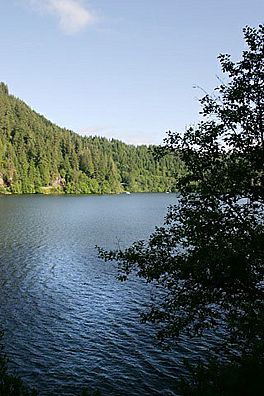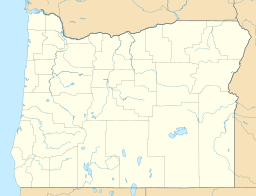Loon Lake (Oregon) facts for kids
Quick facts for kids Loon Lake |
|
|---|---|
 |
|
| Location | Douglas County, Oregon |
| Coordinates | 43°35′13″N 123°50′14″W / 43.58694°N 123.83722°W |
| Type | Landslide-dammed lake, oligotrophic |
| Primary inflows | Lake Creek |
| Primary outflows | Mill Creek |
| Catchment area | 89 sq mi (231 km2) |
| Basin countries | United States |
| Max. length | 2 mi (3 km) |
| Max. width | 0.4 mi (0.6 km) |
| Surface area | 294 acres (119 ha) |
| Average depth | 53 ft (16 m) |
| Max. depth | 105 ft (32 m) |
| Water volume | 15,700 acre⋅ft (19,400,000 m3) |
| Residence time | 1 month |
| Shore length1 | 6.1 mi (9.8 km) |
| Surface elevation | 392 ft (119 m) |
| 1 Shore length is not a well-defined measure. | |
Loon Lake is a beautiful lake in Douglas County, Oregon. It's located in the Oregon Coast Range, about 15 miles (24 km) east-southeast of Reedsport. The lake sits at an elevation of 392 feet (119 m).
Loon Lake is about 2 miles (3 km) long. Its widest point is about 0.4 miles (0.6 km). In some areas, the lake is more than 100 feet (30 m) deep. It covers an area of 294-acre (119 ha).
Contents
How Loon Lake Was Formed
Loon Lake is a special type of lake. It was created by a huge landslide. About 1,400 years ago, a large amount of sandstone rock slid down a hill. This landslide blocked the valley of Lake Creek. The water then backed up behind the natural dam, forming the lake we see today. Lakes formed this way are called "landslide-dammed lakes."
Why Is It Called Loon Lake?
People first discovered Loon Lake in 1852. They named it after the birds they saw on its waters. These birds were loons. Loons are known for their unique calls and their ability to dive deep underwater.
What Kind of Lake Is It?
Loon Lake is considered an oligotrophic lake. This means its waters are very clear. They have low levels of nutrients. This type of lake usually has a lot of oxygen. It also supports certain kinds of fish and plants.
Water Flow In and Out
Lake Creek flows into Loon Lake. This is the lake's main water source. Water then flows out of the lake through Mill Creek. This constant flow helps keep the lake healthy.



